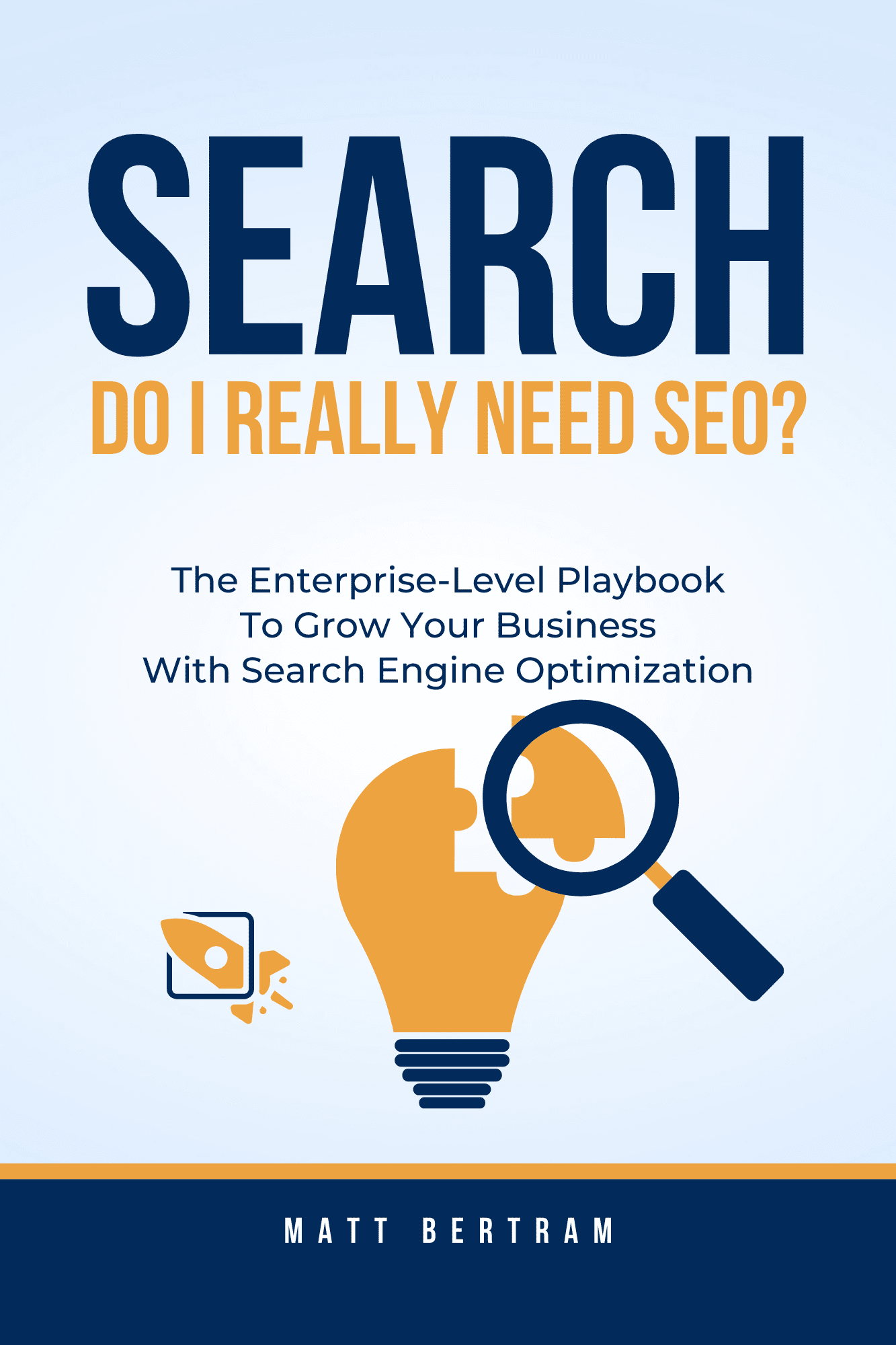
Ever wonder, “What is SEO?”
Once upon a time, in the vast digital kingdom of the internet, there lived a wise and powerful ruler named Google. Google had the ability to connect people with information from all corners of the world, but there was one catch: Google could only understand and communicate through a language known as SEO.
SEO, short for Search Engine Optimization, was like the secret language that allowed websites to speak to Google and gain its favor. It was the art of making websites more visible, more appealing, and more understandable to the great Google.
Imagine you’re throwing a grand party and you want Google to attend. You start by sending out invitations in the form of web pages, each filled with valuable information about your party. These pages represent your website’s content.
Now, Google has a lot of parties to choose from, so it wants to make sure it attends the best ones. It sends out its web crawlers, little bots that explore the internet, scanning and analyzing every page they encounter. These crawlers are like Google’s ears and eyes, gathering information about each party (website) they come across.
But here’s the catch: these web crawlers are incredibly smart, but they’re not human. They don’t understand party invitations written in plain language like humans do. They rely on SEO to make sense of the invitations and decide which party is worthy of Google’s attention.
So, you need to make your party invitation (website) stand out and speak the language of SEO. You carefully craft the content on your web pages, choosing the right keywords, optimizing your headlines, and organizing your information in a logical and user-friendly way. This way, when Google’s crawlers arrive at your party invitation, they can understand what it’s all about and be impressed by its quality.
But it doesn’t end there. Google’s crawlers also pay attention to how many people are talking about your party. They eavesdrop on conversations across the internet, listening for mentions of your party invitation. In the digital realm, these mentions are known as backlinks. The more reputable websites that link back to your invitation, the more popular and trustworthy it appears to Google.
So, you put on your social butterfly hat and start networking. You reach out to influencers, bloggers, and other websites, sharing your party invitation and asking them to spread the word. As the backlinks start pouring in, Google’s crawlers notice the buzz surrounding your party, and they become even more excited to attend.
As the day of the party approaches, Google’s crawlers have gathered enough information to make a decision. They report back to Google, giving it a detailed summary of the parties they’ve explored. Based on their findings, Google compiles a list of the best parties, ranking them in order of importance and relevance.
Finally, the moment arrives. Google, armed with the knowledge gathered by its crawlers, unveils its search results page—the prestigious guest list of parties. The websites that have successfully mastered the language of SEO and impressed Google’s crawlers find themselves at the top of the list, basking in the glory of high rankings and increased visibility.
And just like that, SEO becomes more than a technical process; it becomes a conversation with Google, where you use the right words, present your information clearly, and build a network of connections to ensure your website’s invitation stands out among the crowd.
Remember, in the digital kingdom, where Google reigns supreme, mastering the art of SEO is like speaking the language of the most influential party planner in the land. So, craft your invitation carefully, spread the word, and get ready to welcome Google to your digital extravaganza.
SEO is probably the biggest buzzword of the marketing industry, but do you know what it means? Read on to find out the definition, what SEO stands for, and what it actually is below.
What is SEO?
SEO, or Search Engine Optimization, is a comprehensive set of techniques and strategies used to improve the visibility, ranking, and organic (non-paid) traffic of a website in search engine results pages (SERPs). It involves optimizing various aspects of a website, including its content, structure, and technical elements, to align with search engine algorithms and user search intent.
The primary goal of SEO is to enhance a website’s relevance and authority in the eyes of search engines, such as Google, Bing, and Yahoo, to increase its chances of appearing prominently in search results for relevant queries. By improving a website’s visibility and ranking, SEO aims to drive organic traffic, attract qualified visitors, and ultimately generate conversions and achieve business objectives.
SEO encompasses both on-page and off-page optimization strategies. On-page SEO focuses on optimizing individual web pages by optimizing content quality, keyword usage, meta tags, headers, URLs, and internal linking structure. It also involves improving user experience, site speed, mobile-friendliness, and ensuring proper indexing and crawling by search engine bots.
Off-page SEO, on the other hand, involves activities conducted outside of the website itself to improve its search engine rankings and authority. It includes building high-quality backlinks from reputable websites, social media marketing, online reputation management, influencer outreach, and content promotion through various channels.
Successful SEO requires a deep understanding of search engine algorithms, keyword research, competitor analysis, user behavior, and ongoing monitoring and analysis of website performance. It is a continuous process that requires adapting to algorithm updates, staying abreast of industry trends, and consistently optimizing and improving the website’s SEO factors.
Overall, SEO serves as a vital digital marketing strategy that helps businesses increase their online visibility, attract targeted traffic, build brand awareness, and achieve long-term sustainable growth in the competitive online landscape.
SEO is an acronym, an abbreviation formed from the initial letters of other words and pronounced as a word (other examples include NASA or FEMA). So what does it stand for? Well, SEO stands for Search Engine Optimization.
What are SERPS?
SERPs stands for Search Engine Results Pages. These are the pages displayed by search engines in response to a user’s search query. When you perform a search on a search engine like Google, the search engine algorithm analyzes various factors and determines the most relevant web pages to display in the search results.
SERPs typically include a list of organic search results, which are the non-paid listings that are considered most relevant to the user’s query. Each organic result usually consists of a title, a brief description (snippet), and a URL. These results are ranked based on their relevance to the search query and their perceived quality by the search engine.
In addition to organic results, SERPs may also include paid advertisements, featured snippets, knowledge panels, local map packs, images, videos, news articles, and other types of content, depending on the nature of the search query.
The goal of SEO (Search Engine Optimization) is to improve a website’s visibility and ranking on SERPs. By optimizing various on-page and off-page factors, businesses aim to appear higher in the organic search results, increasing their chances of attracting relevant traffic and potential customers. It’s important for businesses to understand SERPs and how they work to develop effective SEO strategies and enhance their online presence.
SERPs are the digital battlegrounds where websites compete for visibility and users’ attention, shaping the online destiny of businesses.
How does Google choose what results to show you?
So how does Google choose what results to show you?
Google uses a complex algorithm to determine the results it shows in response to a user’s search query. While the exact details of the algorithm are not publicly disclosed, Google considers numerous factors to assess the relevance and quality of web pages. Here are some key elements that influence Google’s selection of search results:
- Relevance: Google aims to provide search results that are most relevant to the user’s query. The algorithm analyzes various signals, including the presence of the search terms in the content, title tags, headings, and meta descriptions of web pages.
- Page Quality: Google evaluates the overall quality of web pages. Factors such as the content’s depth, accuracy, and uniqueness are assessed. Pages with well-structured and organized content tend to rank higher.
- Backlinks: Google considers the number and quality of backlinks pointing to a web page. Backlinks act as “votes of confidence” from other websites, indicating that the page is trustworthy and valuable.
- User Experience: Google takes into account factors related to the user experience, such as page loading speed, mobile-friendliness, and ease of navigation. Websites that provide a positive user experience are more likely to rank higher.
- Website Authority: Google assesses the overall authority and reputation of a website. Established websites with a history of delivering quality content and attracting natural backlinks tend to have higher authority.
- Freshness: For certain types of queries, Google considers the freshness of the content. News articles, recent events, and time-sensitive topics may receive preference for displaying the most up-to-date information.
- Personalization: Google may personalize search results based on factors like the user’s search history, location, and preferences. This ensures that users receive more relevant and personalized search results.
It’s important to note that Google’s algorithm is constantly evolving, and updates are rolled out regularly to enhance the search experience. As a result, SEO practices need to adapt to these changes to maintain or improve search rankings.
But if you want your website to be on that first page of search results for “b2b oil and gas sales,” there are a few things you can do to help make that happen. Yes, you have some control over where your website ends up in search results!
Examples of Ranking Factors Include:
SEO: Unlocking the digital doorway to online success by optimizing your website’s visibility and enticing Google to roll out the red carpet for your brand.
Google considers numerous factors when ranking websites in its search results. While the exact algorithm is complex and constantly evolving, here are some examples of key ranking factors:
- Content relevance and quality: Google values well-written, informative, and unique content that matches user search queries.
- Backlinks: The number and quality of websites linking to your site can indicate its authority and trustworthiness.
- User experience: Google assesses factors like page loading speed, mobile-friendliness, and ease of navigation to ensure a positive experience for users.
- On-page optimization: This includes factors like keyword usage, meta tags, headings, and URL structure to optimize your website’s visibility to search engines.
- User engagement metrics: Google monitors metrics such as bounce rate, time on page, and click-through rate to gauge user satisfaction and the relevance of your content.
- Social signals: The level of engagement and shares on social media platforms can indirectly influence rankings.
- Site architecture and structure: A well-organized website with clear hierarchies and internal linking helps search engines understand and crawl your content effectively.
- Mobile responsiveness: With the growing use of mobile devices, having a mobile-friendly website is crucial for ranking well in mobile search results.
- Domain age and authority: Established domains with a history of quality content and backlinks tend to have an advantage in rankings.
- Secure and accessible website: Google prioritizes websites with HTTPS encryption and good accessibility practices.
It’s important to note that these factors are just a snapshot of the many elements Google considers, and their relative importance can vary. Keeping up with SEO best practices and focusing on providing value to users is key to improving your website’s rankings.
Domain Authority – A score that predicts how well a website will rank on search engine results pages.
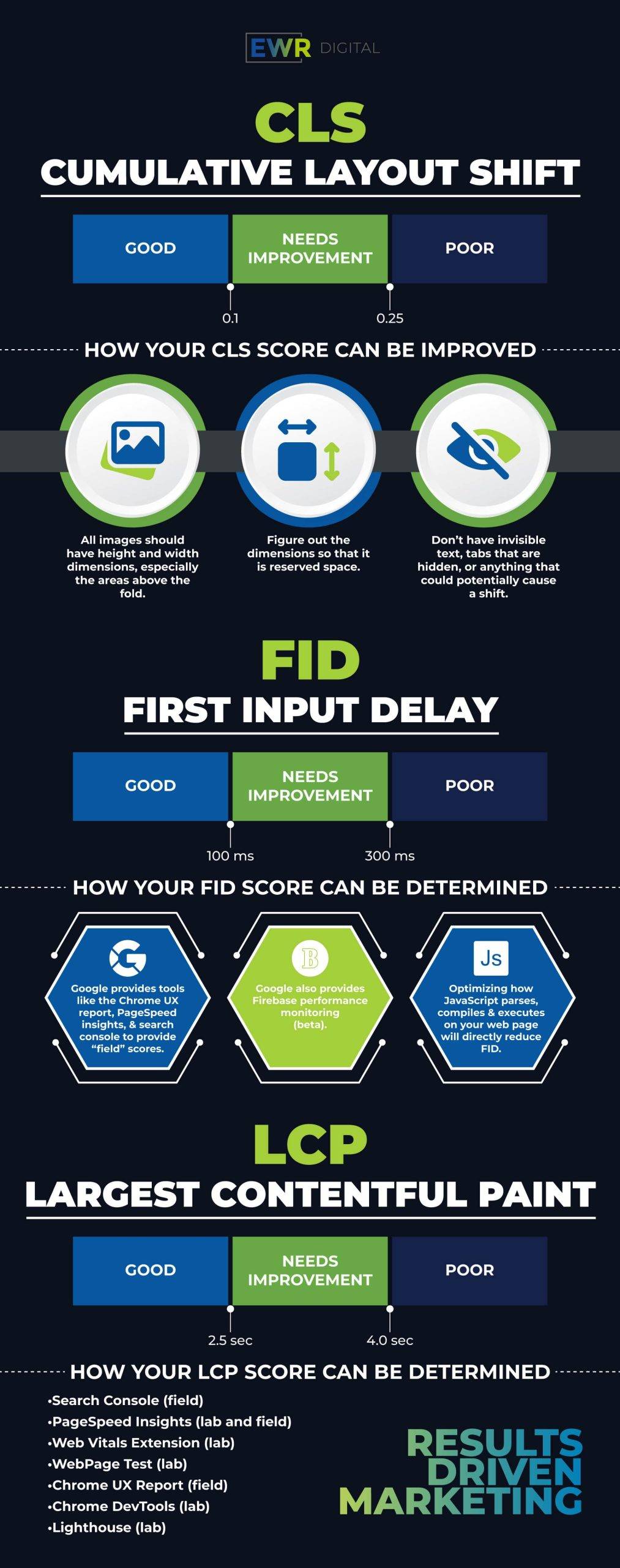
What are Core Web Vitals?
Core Web Vitals are a set of specific website performance metrics identified by Google that are essential for delivering a great user experience. These metrics measure various aspects of web page loading, interactivity, and visual stability. The Core Web Vitals consist of three key metrics:
- Largest Contently Paint (LCP): LCP measures the loading speed of the main content element on a web page. It indicates the time taken for the largest image or text block to become visible to the user. The recommended LCP value is less than 2.5 seconds.
- First Input Delay (FID): FID measures the responsiveness of a web page by tracking the time between a user’s first interaction (such as clicking a button or a link) and the browser’s response to that interaction. It reflects the page’s interactivity. An ideal FID value is less than 100 milliseconds.
- Cumulative Layout Shift (CLS): CLS measures the visual stability of a web page by calculating the amount of unexpected layout shifts that occur during the page’s loading phase. It quantifies how much page content moves around unexpectedly, which can be disruptive to users. A good CLS value is less than 0.1.
These Core Web Vitals provide website owners and developers with standardized metrics to evaluate and improve the user experience of their web pages. Google considers these metrics when assessing page experience signals and determining search rankings, making them crucial for optimizing websites for better performance and user satisfaction.
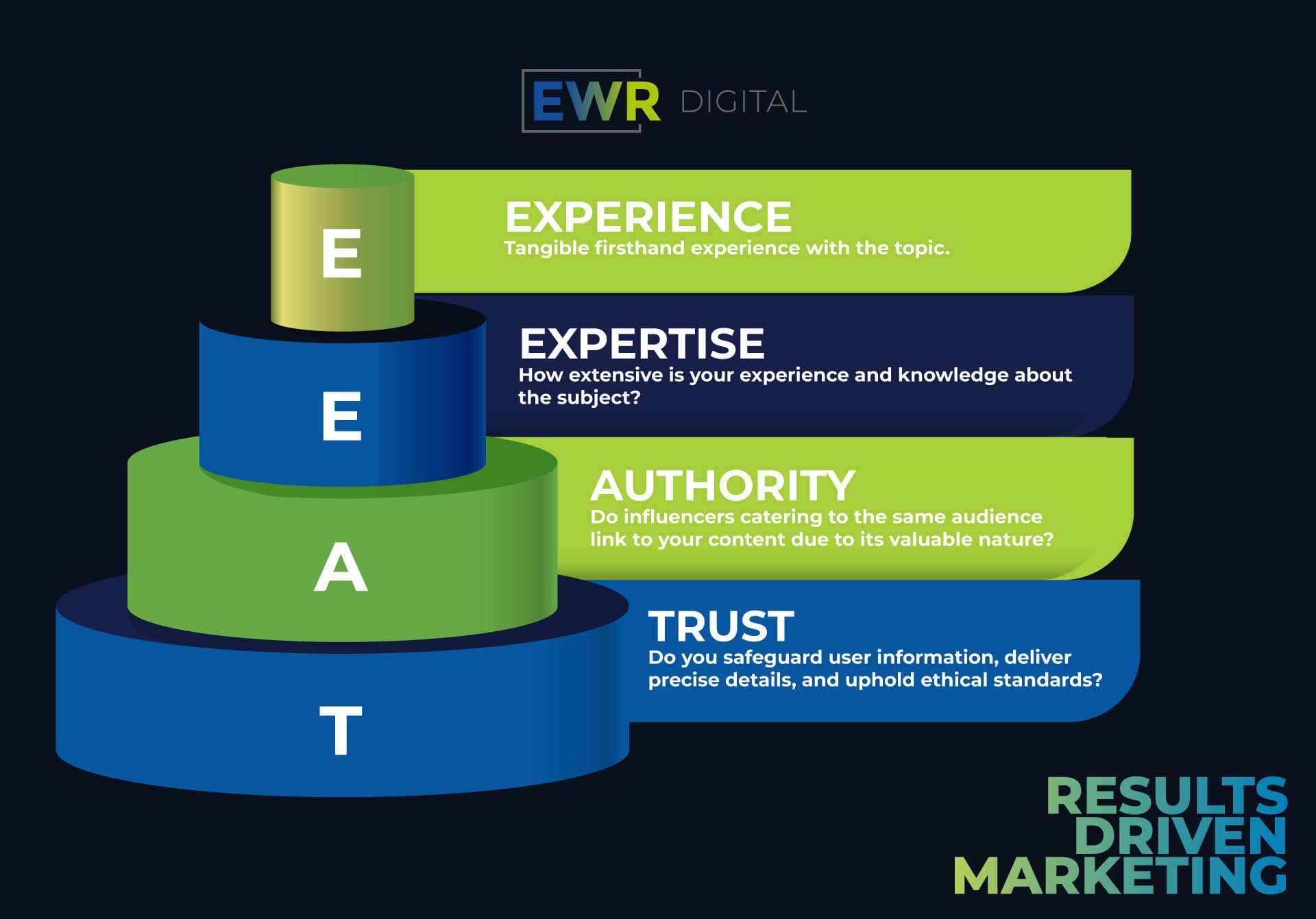
What is Google E-E-A-T?
E-A-T stands for Expertise, Authoritativeness, and Trustworthiness, and it is a framework introduced by Google in its search quality guidelines. It is a concept that Google considers when evaluating the quality and relevance of webpages to determine their rankings in search results. E-A-T is used to evaluate the quality and credibility of web content, particularly for topics that require a high level of trust and expertise, such as medical, financial, or legal information (YMYL).
Here’s a breakdown of each component of E-A-T:
Expertise:
Expertise refers to the knowledge, skills, and experience of the content creator or the website as a whole. Google looks for evidence that the content is produced by individuals or organizations with expertise in the subject matter. This can be demonstrated through qualifications, credentials, industry recognition, or a track record of producing high-quality, accurate content.
Authoritativeness:
Authoritativeness measures the reputation and authority of the content creator and the website itself. Google considers factors such as the website’s reputation, backlinks from other authoritative sources, and the overall online presence and influence of the content creator. High-quality content from reputable sources is more likely to be considered authoritative.
Trustworthiness:
Trustworthiness relates to the reliability and credibility of the content and the website as a whole. Google assesses factors such as the accuracy of the information, transparency about the content creator’s identity and motives, and the overall trustworthiness of the website. Content that is reliable, well-sourced, and free from misleading or deceptive practices is given higher credibility.
It’s important to note that E-A-T is particularly relevant for YMYL (Your Money or Your Life) topics, which involve information that can impact a person’s health, finances, or overall well-being. Websites that provide advice or information on these topics are held to higher standards of expertise, authoritativeness, and trustworthiness.
While E-A-T is not a direct ranking factor, Google’s algorithms aim to reward high-quality content that demonstrates strong E-A-T signals. By focusing on providing accurate, well-sourced, and trustworthy information, website owners can enhance their E-A-T signals, improve their credibility, and increase their chances of ranking well in search engine results.
Google has taken E-A-T (Expertise, Authoritativeness, and Trustworthiness) to a new level by adding an extra E, making it E-E-A-T. The additional E stands for experience, bringing a fresh dimension of quality to evaluate search results. So, what does Google look for when it comes to experience?
According to Google, it wants to see content that demonstrates a certain level of experience. This could mean content created by individuals who have hands-on product experience, have actually visited a place, or can effectively communicate their personal experiences. In certain situations, Google values content produced by those with real-life expertise on the topic.
For example, if you’re seeking information on correctly filling out your tax returns, Google suggests looking for content created by accounting experts. On the other hand, if you’re searching for reviews of tax preparation software, you might prefer a forum discussion where people share their experiences with different services.
In the updated guidelines, Google emphasizes that experience, expertise, and authoritativeness contribute to the assessment of trust. However, trust remains the most crucial element within the E-E-A-T framework.
By understanding and incorporating these principles into your content strategy, you can enhance your website’s credibility and visibility in search results.
Experience:
In December 2022, Google introduced E-E-A-T, adding an extra “E” for “Experience” to its search quality rater guidelines. This addition aims to emphasize the significance of firsthand or life experience for content creators when evaluating the quality of search results. Google highlights that content created by individuals with personal experience in a particular topic can be more trustworthy and effective in achieving its intended purpose. For instance, Google poses a question regarding the credibility of a product review: Would you trust a review written by someone who has personally used the product or a review by someone who hasn’t?
By incorporating the element of experience, Google aims to introduce a new dimension of quality assessment to its search results. When assessing content, Google considers whether it demonstrates a certain level of experience, such as firsthand usage of a product, actual visits to a place, or conveying personal experiences. Google explains that certain situations require content produced by individuals with firsthand life experience in the relevant field. For example, when seeking information on correctly filling out tax returns, it is preferable to find content from an expert in the field of accounting. However, when searching for reviews on keyword research software, users might value information from a forum discussion involving people with diverse experiences using different services.
By emphasizing experience, Google aims to enhance the relevance and credibility of search results, providing users with content that is both knowledgeable and informed by firsthand encounters.
Regularly Managing and Updating Website Content
Google encourages website owners to regularly manage and update their content to provide the best possible experience for users. Google’s primary goal is to deliver relevant, up-to-date, and high-quality content to its users in search results.
Google emphasizes the importance of fresh and relevant content. Websites that regularly update their content and add new information have a better chance of ranking well in search results. Regularly updating content not only keeps the website fresh and engaging for users but also signals to search engines that the site is active and actively providing valuable information.
Additionally, Google encourages website owners to follow best practices for managing their websites, such as ensuring proper indexing, using descriptive and accurate metadata, creating unique and compelling page titles, optimizing site speed, and making their websites mobile-friendly. These practices help search engines understand and crawl the website effectively, leading to better visibility and potential ranking improvements.
Furthermore, Google provides various tools and resources to help website owners manage their websites effectively. For example, Google Search Console offers insights into website performance, indexing status, and crawl errors. Google Analytics provides valuable data on user behavior and website traffic. By utilizing these tools and staying proactive in website management, website owners can improve their website’s visibility and performance in search results.
Importance of Authorship
Google’s stance on authorship has evolved over the years. Initially, Google introduced the concept of authorship markup, which allowed content creators to associate their content with their Google or WordPress profiles. This feature aimed to provide more credibility and visibility to authors and their content in search results.
However, in 2014, Google officially announced the removal of authorship markup from search results. The decision was based on various factors, including low adoption rates and the limited impact on search quality. Google stated that the presence of authorship markup had no direct effect on rankings.
Since then, Google has shifted its focus towards other factors that determine the relevance and credibility of content, such as the quality of the content itself, its relevance to the search query, and the authority of the website or domain it’s hosted on. Google primarily relies on signals like backlinks, user engagement metrics, and overall website reputation to assess the value and trustworthiness of content.
While Google doesn’t emphasize authorship markup anymore, it’s still important for content creators to establish their expertise and authority in their respective fields. Building a strong personal brand, creating high-quality content, and promoting it through various channels can help content creators gain visibility and recognition, both within their industry and in search engine results.
Google encourages website owners to regularly manage and update their content to provide the best possible experience for users. Google’s primary goal is to deliver relevant, up-to-date, and high-quality content to its users in search results.
Google emphasizes the importance of fresh and relevant content. Websites that regularly update their content and add new information have a better chance of ranking well in search results. Regularly updating content not only keeps the website fresh and engaging for users but also signals to search engines that the site is active and actively providing valuable information.
Additionally, Google encourages website owners to follow best practices for managing their websites, such as ensuring proper indexing, using descriptive and accurate metadata, creating unique and compelling page titles, optimizing site speed, and making their websites mobile-friendly. These practices help search engines understand and crawl the website effectively, leading to better visibility and potential ranking improvements.
Furthermore, Google provides various tools and resources to help website owners manage their websites effectively. For example, Google Search Console offers insights into website performance, indexing status, and crawl errors. Google Analytics provides valuable data on user behavior and website traffic. By utilizing these tools and staying proactive in website management, website owners can improve their website’s visibility and performance in search results.
What does SEO include?
SEO, or Search Engine Optimization, is a comprehensive and multifaceted process that involves various techniques, strategies, and factors aimed at improving a website’s visibility, ranking, and organic (non-paid) traffic in search engine results pages (SERPs). It encompasses both on-page and off-page optimization tactics, as well as technical aspects to ensure a website is optimized for search engines.
Here is a comprehensive breakdown of what SEO includes:
- Keyword Research: Conducting in-depth research to identify relevant keywords and search terms that users are using to find information related to a specific industry, product, or service.
- On-Page Optimization: Optimizing individual web pages to make them more search engine-friendly. This includes optimizing meta tags (title tag, meta description), headers (H1, H2), URL structure, image alt tags, and ensuring proper keyword usage throughout the content.
- Content Creation and Optimization: Developing high-quality, relevant, and valuable content that satisfies user search intent. This includes creating informative articles, blog posts, product descriptions, guides, and multimedia content (videos, infographics). Content optimization involves incorporating targeted keywords, using proper formatting and structure, and providing a great user experience.
- Technical SEO: Ensuring that a website’s technical elements are optimized for search engines. This includes optimizing site speed, improving mobile-friendliness and responsive design, implementing structured data markup (schema.org), optimizing XML sitemaps and robots.txt files, and resolving crawl errors and duplicate content issues.
- User Experience (UX) Optimization: Focusing on enhancing the overall user experience of a website. This includes improving site navigation, usability, accessibility, and readability. Providing a seamless and intuitive user experience helps increase engagement, reduce bounce rates, and improve search engine rankings.
- Link Building: Acquiring high-quality backlinks from reputable and authoritative websites. Building a strong backlink profile is crucial for off-page SEO, as it signals to search engines the relevance and credibility of a website. This involves outreach, guest blogging, content promotion, social media marketing, and fostering relationships with influencers and industry experts.
- Social Media Integration: Utilizing social media platforms to enhance brand visibility, engage with the target audience, and generate social signals that indirectly influence search engine rankings. This includes sharing and promoting content, responding to user comments and inquiries, and building a strong social media presence.
- Local SEO: Optimizing a website to improve visibility in local search results. This includes optimizing Google My Business profile, local citations, online reviews, and ensuring consistent NAP (Name, Address, Phone) information across online directories.
- Analytics and Reporting: Monitoring, measuring, and analyzing website performance using tools like Google Analytics. This involves tracking organic traffic, keyword rankings, user behavior, conversions, and other relevant metrics to assess the effectiveness of SEO strategies and make data-driven decisions for further optimization.
- Ongoing Optimization and Maintenance: SEO is an ongoing process that requires continuous monitoring, testing, and refinement. It involves staying updated with search engine algorithm changes, adapting strategies accordingly, and continually optimizing various SEO elements to maintain and improve search engine rankings.
By implementing a comprehensive SEO approach, businesses can increase their online visibility, attract targeted organic traffic, build brand authority, and ultimately achieve their marketing and business objectives.
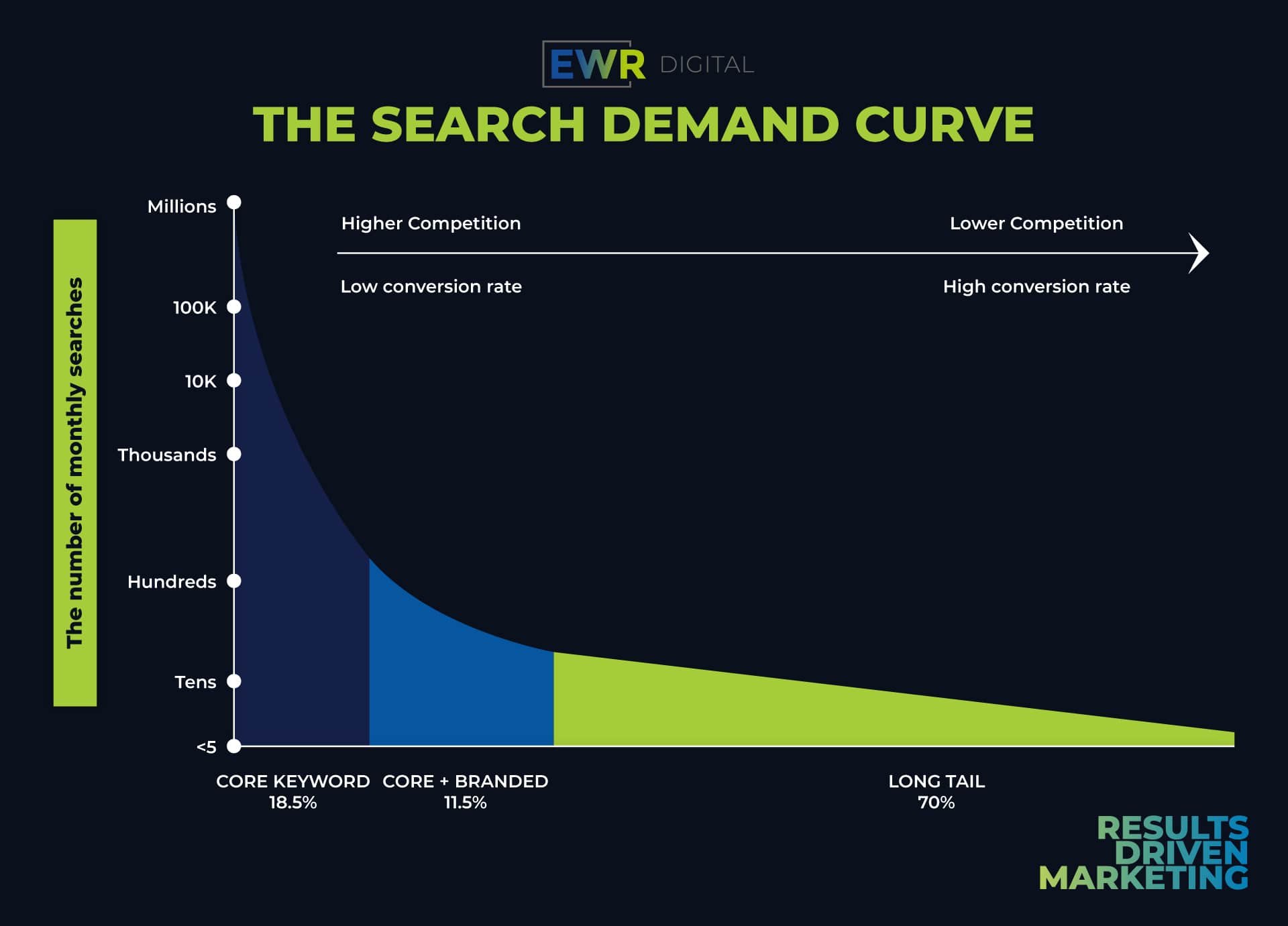
Keyword Research
Keyword research is a fundamental aspect of SEO that involves thorough investigation and analysis of the search terms and phrases that users enter into search engines. It is a crucial step in understanding user intent, identifying relevant topics, and optimizing website content to attract organic traffic effectively.
Comprehensive keyword research involves the following components:
- Understanding Business Goals: Before diving into keyword research, it’s essential to understand the goals and objectives of the business or website. This helps in aligning keyword targeting with the overall marketing strategy and target audience.
- Identifying Seed Keywords: Seed keywords are the initial set of words or phrases related to the business niche. They serve as a foundation for expanding the keyword list. Brainstorming and creating a list of seed keywords helps capture the core topics and themes of the website.
- Expanding Keyword List: Once seed keywords are established, the next step is to expand the list by generating additional keyword ideas. This can be done using various methods:
-
- Keyword Planner Tools: Utilize keyword research tools like Google Keyword Planner, SEMrush, Moz Keyword Explorer, or Ahrefs’ Keywords Explorer to discover related keywords, search volumes, competition levels, and keyword variations.
- Competitor Analysis: Analyze competitor websites and identify the keywords they are targeting. This can provide valuable insights and opportunities for your own keyword strategy.
- Search Suggestions: Use search engines like Google to observe auto-suggestions or related searches that appear when entering seed keywords. These can provide ideas for long-tail keywords and user search variations.
- Customer Surveys and Feedback: Gain insights from customers and target audience through surveys, interviews, or feedback forms to understand their language, pain points, and the terms they use to search for information related to your business.
- Keyword Metrics Evaluation: Once a substantial list of potential keywords is generated, it’s important to evaluate their metrics to prioritize and select the most relevant ones. Key metrics to consider include:
- Search Volume: The average number of monthly searches for a specific keyword. Focus on keywords with a reasonable search volume to ensure potential traffic.
- Competition Level: Assess the level of competition for each keyword. Highly competitive keywords may be challenging to rank for, so it’s important to balance with less competitive or long-tail keywords.
- Relevance: Evaluate the relevance of keywords to the website’s content and target audience. Select keywords that closely align with the website’s topics and match user intent.
- Commercial Intent: Consider the intent behind keywords. Some keywords may indicate high commercial intent, suggesting users are looking to make a purchase or engage in a specific action. These can be valuable for businesses aiming to drive conversions.
- Grouping and Organizing Keywords: Categorize keywords into logical groups or themes based on their relevance and intent. This helps in organizing website structure, creating content clusters, and mapping keywords to specific pages or sections of the website.
- Long-Tail Keywords: Incorporate long-tail keywords into the research. These are more specific and longer phrases that often have lower search volumes but can attract highly targeted traffic. Long-tail keywords can contribute to overall keyword diversity and capture users with more specific queries.
- Analyzing Keyword Difficulty: Assess the difficulty of ranking for specific keywords. Keyword difficulty takes into account factors such as competition, domain authority, and backlink profiles of top-ranking pages. It helps identify opportunities where ranking might be more achievable.
- Refining and Iterating: Keyword research is an iterative process. Regularly review and refine the keyword list based on performance data, changes in user behavior, or evolving business goals. Stay up-to-date with industry trends and adapt the keyword strategy accordingly.
The first step to starting SEO is doing some keyword research. There are a ton of great resources out there for keyword research, like the Google AdWords Keyword Planner.
The right keywords for you may vary depending on your business type and industry. It’s generally best to start with low competition keywords to build your authority and then slowly start adding in more competitive keywords as you grow.
Unsure where to start? Take a look at what people are searching for related to your industry in your city. For example, if you’re a pool cleaning company in Orlando, Florida, try using keywords like “pool cleaning Orlando” and “Orlando pool cleaners.”
Google AdWords Keyword Planner can show you search volume, price, and competition rates all side by side, and it’s just a great asset for any marketer out there.
The more relevant links you have, the better your UR score.
URL Rating (UR) shows the strength of your target page’s backlink profile on a 100-point logarithmic scale. If you analyze a domain, the homepage’s UR is shown by Ahrefs metrics.
Aspects of SEO
- On-Page Optimization: On-page optimization refers to the techniques used to optimize individual web pages to improve their visibility in search engine rankings. This includes optimizing meta tags, such as the title tag (which appears as the clickable headline in search results) and the meta description (a brief summary of the page’s content). By including relevant keywords in these tags and ensuring they accurately describe the page’s content, you can help search engines understand what your page is about.
- Off-Page Optimization: Off-page optimization involves activities that take place outside of your website but have an impact on its search engine rankings. One of the key components of off-page optimization is building backlinks from other reputable websites. Backlinks act as votes of confidence for your site, indicating to search engines that your content is valuable and trustworthy. Social media promotion and online reputation management also fall under off-page optimization, as they contribute to building your brand’s online presence and credibility.
- Technical SEO: Technical SEO focuses on optimizing the technical aspects of your website to improve its performance and indexability by search engines. This includes tasks such as optimizing site speed to ensure fast loading times, making your website mobile-friendly, fixing broken links that can hinder the crawling of your site, creating XML sitemaps to help search engines understand the structure of your website, and implementing structured data markup to provide additional context to search engines.
- Content Optimization: Content optimization is a crucial part of SEO. It involves creating high-quality, relevant, and valuable content that satisfies user intent. Keyword research plays a vital role in content optimization as it helps you understand the words and phrases users are searching for. By incorporating these keywords naturally into your content, you can improve its visibility in search results. However, it’s important to focus on creating content that provides genuine value to your audience, rather than simply stuffing it with keywords.
- User Experience: User experience refers to the overall experience that users have when interacting with your website. Search engines consider user experience as an important ranking factor because they want to deliver the best possible results to their users. Optimizing user experience involves ensuring easy navigation, intuitive design, clear call-to-actions, and mobile responsiveness. By providing a positive user experience, you not only improve your website’s chances of ranking higher but also enhance user satisfaction and engagement.
- Analytics and Tracking: Analytics and tracking tools like Google Analytics help you monitor and analyze the performance of your website. By tracking metrics such as organic traffic, keyword rankings, bounce rates, and conversions, you can gain valuable insights into the effectiveness of your SEO efforts. This data enables you to identify areas for improvement, understand user behavior, and make informed decisions to optimize your website further.
- Local SEO: Local SEO is important for businesses targeting a specific geographic area. It involves optimizing your website and online presence to rank higher in local search results. Local SEO strategies include optimizing for location-specific keywords, claiming and optimizing your Google My Business listing, managing online reviews, and ensuring NAP consistency (Name, Address, Phone number) across online directories. These efforts help businesses increase their visibility to local customers and drive more foot traffic to physical stores.
Other Categories of SEO:
- Enterprise SEO: Enterprise SEO refers to the practice of optimizing a large-scale website with multiple pages and complex structures to improve its visibility and organic search rankings on search engine results pages (SERPs).
- International SEO: International SEO involves optimizing a website to target and attract organic traffic from different countries and regions, considering language, cultural nuances, and search engine preferences in order to achieve global visibility and reach.
- B2B SEO: B2B SEO focuses on optimizing a website and its content to increase organic visibility and drive targeted traffic from search engines specifically for business-to-business (B2B) companies, with a focus on capturing and converting leads from other businesses.
By considering and implementing these various aspects of SEO, businesses can enhance their online presence, attract more organic traffic, and ultimately achieve their marketing and business objectives.
“SEO is not just about being found. It’s about being found by the right audience.”
Why Your Business Needs SEO
Implementing SEO (Search Engine Optimization) is crucial for businesses of all sizes, industries, and online presence. It offers numerous benefits that can significantly impact the success and growth of a business. Here are the key reasons why SEO is essential for businesses:
- Increased Organic Visibility: SEO helps businesses improve their organic visibility in search engine results pages (SERPs). By optimizing website content, structure, and technical aspects, businesses can increase their chances of appearing higher in search rankings. Higher visibility leads to more exposure, which can result in increased website traffic and brand awareness.
- Targeted Traffic and Qualified Leads: SEO focuses on targeting specific keywords and optimizing website content to match user intent. This ensures that the traffic driven to the website is relevant and more likely to convert into leads or customers. By attracting users actively searching for products or services related to their business, companies can generate high-quality, targeted traffic.
- Cost-Effective Marketing: SEO is a cost-effective marketing strategy compared to other digital advertising methods. While it requires an initial investment in terms of time, resources, and expertise, the long-term benefits can be substantial. Once a website gains visibility and rankings, the ongoing traffic generated from organic search is essentially free, reducing the need for paid advertising.
- Enhanced User Experience: SEO involves optimizing various aspects of a website, such as site speed, mobile-friendliness, easy navigation, and engaging content. These optimizations improve the overall user experience, making it easier for visitors to find information, navigate through the site, and engage with the content. A positive user experience leads to increased user satisfaction, longer on-site engagement, and higher chances of conversions.
- Brand Credibility and Trust: Appearing in top search results gives businesses a sense of authority and credibility in the eyes of users. Users tend to trust websites that rank well in organic search results, considering them more reliable and trustworthy. By investing in SEO and appearing prominently in search, businesses can build brand credibility, trust, and establish themselves as industry leaders.
- Competitive Advantage: In today’s digital landscape, businesses face fierce competition. SEO can provide a competitive edge by helping a business stand out from its competitors. Ranking higher in search results, targeting niche keywords, and delivering relevant content can differentiate a business and attract users who may have otherwise chosen a competitor.
- Long-Term Sustainable Results: Unlike some other marketing tactics that provide short-term results, SEO offers long-term sustainability. While it may take time to see significant improvements in rankings and organic traffic, the efforts invested in SEO can have a lasting impact. Once a website establishes its authority, consistently produces valuable content, and maintains technical optimizations, it can continue to attract organic traffic and generate leads over time.
- Adaptation to Changing Consumer Behavior: Consumer behavior has shifted significantly towards digital channels, with search engines being the primary source of information. By implementing SEO, businesses can align with this change in behavior and ensure their online presence is optimized to meet the needs and preferences of their target audience.
There are over 1.3 billion websites on the internet today. Amidst all of that, how can you ensure you get found by potential customers? The answer is SEO.
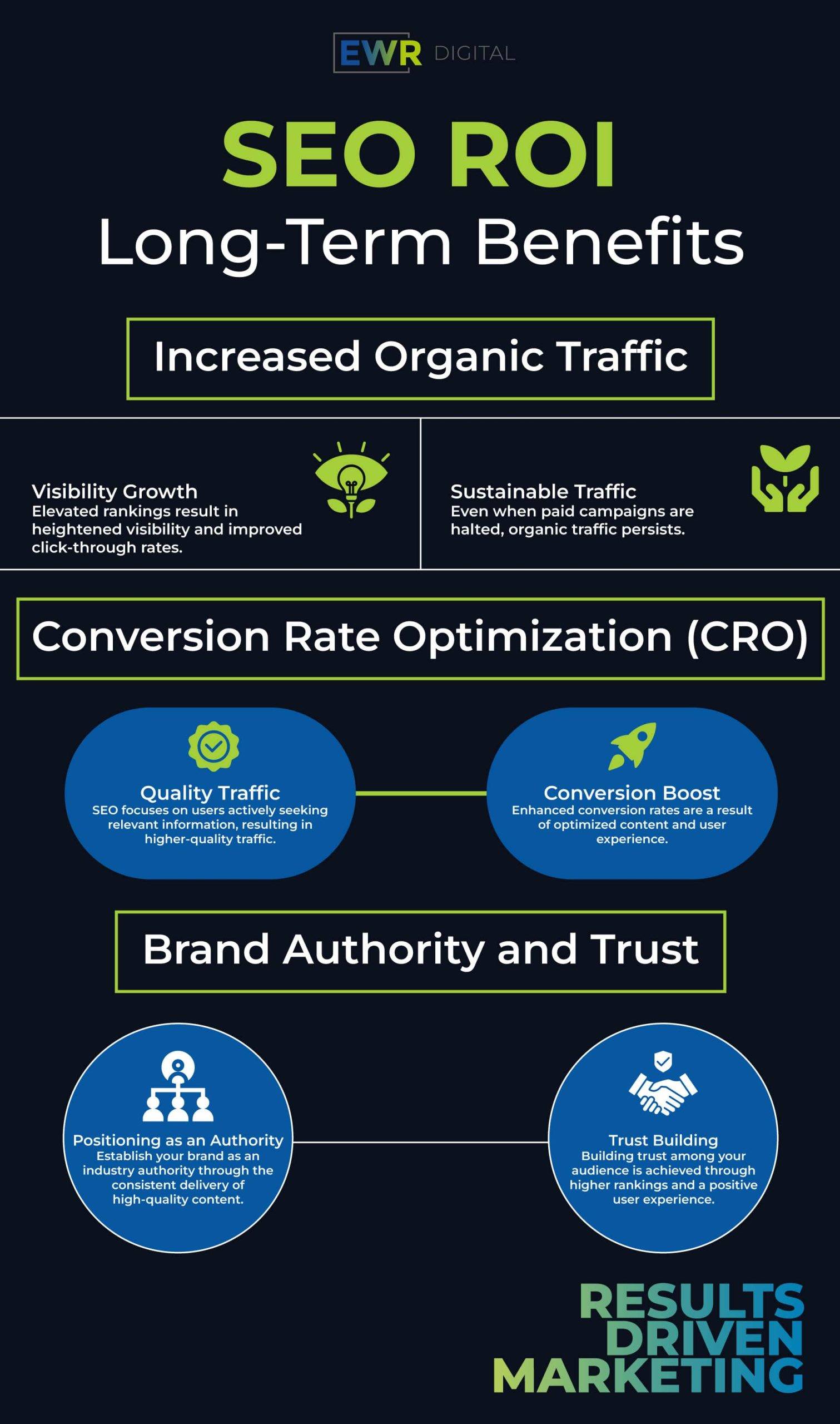
Your content goes here. Edit or remove this text inline or in the module Content settin
There are over 1.3 billion websites online. SEO can make you stand out!
Introducing EWR Digital: The Award-Winning SEO Company You Need!
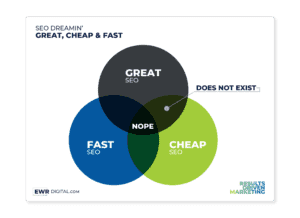
Are you tired of struggling to achieve online visibility and drive organic traffic to your website? Look no further! EWR Digital, the award-winning SEO agency, is here to skyrocket your online success and leave your competitors in the dust.
Why should you choose EWR Digital?
Here’s why:
- Unmatched Expertise: Our team of SEO experts has been recognized and awarded for their exceptional knowledge and skills in the industry. With years of experience under our belt, we know the ins and outs of search engine optimization like no other. When you partner with us, you can trust that you’re working with true industry leaders who will deliver outstanding results.
- Proven Track Record: Our award-winning SEO strategies have helped numerous businesses achieve remarkable online success. We have a portfolio filled with success stories, showcasing how we’ve catapulted our clients’ websites to the top of search engine rankings and boosted their organic traffic. Join the ranks of our satisfied clients and experience the power of our proven methods.
- Cutting-Edge Techniques: SEO is an ever-evolving landscape, and we stay at the forefront of the industry by constantly adapting and innovating. Our team leverages the latest tools, technologies, and trends to ensure your website is optimized for maximum visibility and discoverability. We leave no stone unturned when it comes to staying ahead of the competition.
- Customized Strategies: We understand that every business is unique, and a one-size-fits-all approach won’t cut it. That’s why we take the time to understand your specific goals, target audience, and industry landscape. We then tailor our award-winning SEO strategies to suit your business, ensuring maximum impact and delivering results that align with your objectives.
- Transparent and Collaborative Approach: We believe in building strong partnerships with our clients. Throughout the entire process, we maintain open lines of communication, keeping you informed and involved at every step. We provide detailed reports and analytics, giving you full visibility into the progress of your SEO campaigns. We’re not just your SEO agency; we’re your trusted advisors.
Don’t settle for mediocre results when you can work with an award-winning SEO company that knows how to deliver excellence. Contact EWR Digital today and let us unlock the full potential of your online presence. Remember, success favors the bold, and we’re here to help you conquer the digital landscape like never before.
Now that we’ve answered “What is SEO?” for you, you can ask us all your other burning questions about SEO and internet marketing!
Simply schedule a call to speak with one of our seo experts! Ready to grow your business? So are we.
SEO is like a strategic game of chess, where each move determines your online success. It’s about outsmarting your competitors, anticipating search engine algorithms, and making calculated moves to secure the top positions. At EWR Digital, we thrive on this exhilarating challenge. – Matt Bertram
What Is SEO? | EWR Digital – Houston, TX Internet Marketing
gs. You can also style every aspect of this content in the module Design settings and even apply custom CSS to this text in the module Advanced settings.

